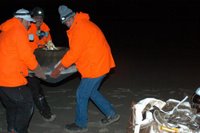Stardust Trivia (I love Space trivia)
The Stardust samples are the first samples from space returned to Earth from a comet and the first samples returned from anywhere farther away than the moon.
The 101-pound (46-kilogram) Stardust capsule returned to Earth, slamming into the atmosphere at a blistering 29,000 miles per hour – the greatest velocity ever attained by any human-made object diving into Earth’s atmosphere on record.
Stardust was launched on February 7, 1999. The encounter and cometary dust sample collection at comet Wild 2 occurred January 2, 2004 – with the spacecraft flying by the comet at roughly 149 miles distance.
The 101-pound Stardust capsule then returned to Earth and the sample return capsule landed at the Utah Test and Training Range, touching down on the desert floor under parachute.
 After the capsule’s recovery, a “bank vault-like” canister holding the interstellar and comet samples was removed in Utah for transportation to NASA Johnson Space Center(see photo at right), in Houston, Texas, where the capsule was opened.
After the capsule’s recovery, a “bank vault-like” canister holding the interstellar and comet samples was removed in Utah for transportation to NASA Johnson Space Center(see photo at right), in Houston, Texas, where the capsule was opened.A preliminary estimation is that there might be more than a million microscopic specks of dust embedded in Stardust’s aerogel-laden collector.
JSC will be the curator of the samples collected by Stardust from comet Wild 2, as well as the interstellar dust particles that Stardust snagged during its nearly seven year voyage. As many as 150 scientists worldwide are awaiting samples to study.
Choose Your Own Adventure - The Stardust "mother craft" that successfully ejected the sample return capsule is still up in Space.
Mission controllers have placed the spacecraft into a "divert maneuver"—to keep the hardware from hitting Earth. It has been put on an orbit around the Sun.
After nearly seven years of space travel, the solar-powered Stardust and onboard gear—including an operational navigation camera—have weathered well. An expected 44 pounds (20 kilograms) of fuel should be left onboard after the divert maneuver.
"NASA has no current plans for an extended mission," said Tom Morgan, Stardust Program Scientist and Executive at NASA Headquarters in Washington, D.C. However, individuals who wish to propose post-return uses for the spacecraft to NASA may submit a proposal for the use of the spacecraft in response to the current Discovery Announcement of Opportunity, a document released on January 3, 2006, Morgan told SPACE.com via email.
"If NASA declines to accept any of these proposals—or if none are submitted—the spacecraft will be decommissioned," Morgan said.
Read more at Nasa's Stardust site(link)
No comments:
Post a Comment